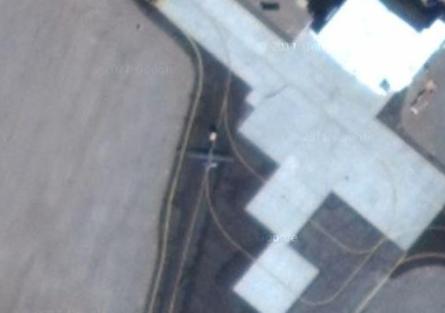A new satellite image of an isolated airstrip in Nevada shows a secret but operational unmanned air vehicle (UAV) test facility. The Yucca Lake airfield, deep inside the heavily restricted Tonopah Test Range, is on land owned by the National Nuclear Security Administration (NNSA), a division of the Department of Energy (DoE), but was constructed and operated by an undisclosed government customer.
The satellite image, taken in early 2011 and available on Google Maps, appears to show a roughly 5,200 ft (1,580m) asphalt runway and what appears to be a General Atomics MQ-1 Predator or MQ-9 Reaper UAV being towed on the parking ramp.
The airfield has four hangars of varying sizes, including a hangar with clamshell doors that is characteristic of US UAV operations. Details of the airfield, including a parking lot, security perimeter and ongoing construction are clearly visible.
The hangars could accommodate a total of between 10-15 MQ-9 Reaper aircraft, according to Tim Brown, an imagery analyst with Globalsecurity.org.
 |
|---|
© Google Maps |
An earlier image, showing what appear to be a Pilatus PC-12 and Beechcraft King Air parked on the ramp, has fuelled speculation that the facility is used by Lockheed Martin.
Lockheed operates at least two PC-12s that are often flown between the company's extensive Palmdale, California facility and Las Vegas-area airports. Though the company's aircraft have been seen at area public and military airports, sources indicate that aircraft bound for classified airfields often file flight plans for public airports, cancel them when nearby and proceed using visual flight rules (VFR), which are not tracked.
Several classified Lockheed UAVs, including the Polecat technology demonstrator and RQ-170 Sentinel, were tested at airfields on the range, though the specific airfields have not been disclosed. The RQ-170 is operated by US Air Force units at Creech AFB and Tonopah Test Range airfield, both nearby. Lockheed also manufactures the Hellfire missile, which is standard equipment on US Predator and Reaper aircraft.
Lockheed had no immediate comment.
 |
|---|
© Google Maps |
Though Predator-class aircraft are operated by several government and military agencies, one construction company involved with the Yucca Lake project lists it as a classified US Air Force installation. Yet Yucca Lake's isolation from other highly classified sites, including nearby Groom Lake and Tonopah Test Range in Nevada and Dugway Proving Ground in Utah, suggests that even normal military secrecy is insufficient.
One potential conclusion is that Yucca Lake is where the Central Intelligence Agency (CIA) tests hardware and software for its large but classified UAVe programme. The CIA is known to operate Predator-class UAVs, amongst others. A covert CIA base at Shamsi, in Pakistan's Balochistan Province, was publically revealed when satellite images displayed three Predator aircraft and a clamshell hangar at the otherwise isolated airstrip.
The Yucca Lake airfield was constructed beginning around 2002, according to historical imagery of the facility, expanded from a much smaller facility and a small dirt runway. Though official requests for information draw little immediate response, scattered public sources of information are available.
A safety analysis of Yucca Mountain nuclear storage facilities, written by Bechtel SAIC, contains a description of the airfield: "The purpose of this facility is to construct, operate, and test a variety of unmanned aerial vehicles. Tests include, but are not limited to, airframe modifications, sensor operation, and onboard computer development. A small, manned chase plane is used to track the unmanned aerial vehicles."
Two DoE environmental studies provide further details, including operational details. According to those studies, the base operates four to six UAV flights and two to four manned flights per day, flying mainly over the dry lakebed at altitudes under 12,000ft (3,650m).
The facility can accommodate up to 80 people, and facilities include sophisticated maintenance areas. One study notes that "the nature of the aircraft prevents using normal washing techniques. Aircraft would be wiped down by hand when cleaning is required." The same document references the construction of "Squadron Operations/Maintenance Facilities".
Predator aircraft, which have a sensitive skin coating, are cleaned by hand.
The runway shares the name and identifier of an old DoE dirt airstrip that was used to support nuclear testing during the Cold War. The larger dirt strip was deactivated in the 1960s, but FAA airfield records still show information for that runway, along with the notation, "owner desires airport not be charted."
DoE's Nevada facilities are frequently used for "work for others," including the Departments of Defense (DoD) and Homeland Security (DHS).
Source: Flight International
















